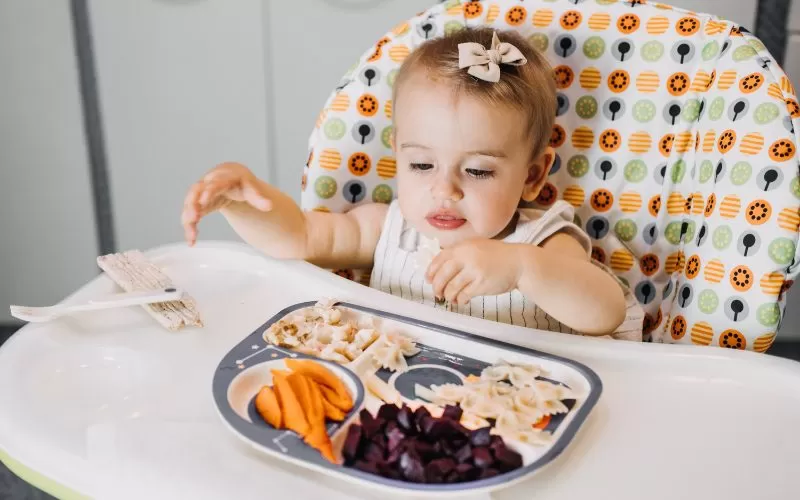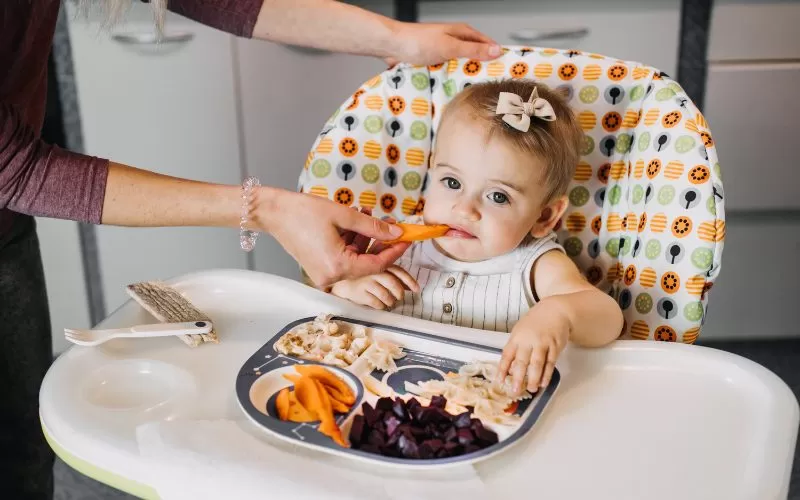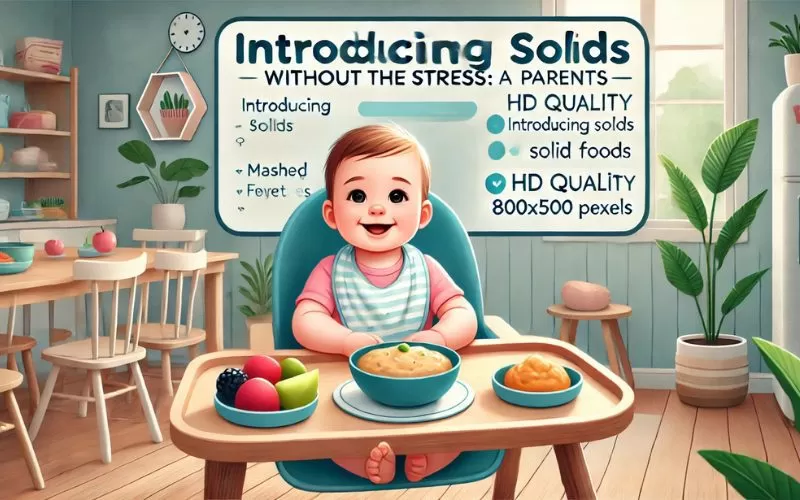Table of Contents
Introducing Solids Guide Parents
Starting your baby on solid foods is an exciting milestone, but it can also come with its share of anxiety. Many parents wonder how to begin, what foods to introduce first, and how to ensure their baby is getting the right nutrition. In this comprehensive guide, we’ll walk you through everything you need to know about introducing solids without the stress, from choosing the best first foods to creating a positive, stress-free mealtime routine. Let’s get started!
As you embark on this exciting journey of introducing solid foods, it’s essential to ensure your baby receives a variety of tastes and textures. The CDC recommends starting with purees and gradually incorporating thicker consistencies as your child develops. For more detailed guidelines on what foods to introduce first and tips for a smooth transition, check out the CDC’s comprehensive guide on introducing solid foods.
When Is Your Baby Ready for Solids?

Introducing solid foods is a gradual process, and it’s important to wait until your baby shows clear signs of readiness. Typically, most babies are ready between 4 to 6 months of age, but every baby is different. It’s crucial to observe your baby’s development and consult with your pediatrician before beginning this transition.
Here are some signs your baby may be ready to start solids:
- Sitting up with minimal support: Your baby should be able to sit upright in a highchair or on your lap to avoid choking.
- Interest in food: If your baby watches you eat with curiosity or tries to grab your food, they may be showing interest in eating.
- Loss of the tongue-thrust reflex: Babies have a natural reflex to push food out of their mouths with their tongues. When this reflex fades, they may be ready for solids.
- Good head and neck control: Your baby should be able to hold their head steady while sitting.
Starting solids is an exciting time, but there’s no need to rush. Every baby develops at their own pace. Once your baby shows these signs, you can start offering solid foods alongside breastfeeding or formula.
Starting Solids Without the Stress

When it comes to starting solids, simplicity is key. Begin with single-ingredient purees like mashed banana, avocado, or sweet potato. These foods are gentle on your baby’s stomach and provide essential nutrients. Introducing one new food every 3-5 days will allow you to watch for any potential allergic reactions. Foods like cereals fortified with iron or soft, steamed vegetables are excellent first choices.
Remember, the goal at this stage is not to replace breastmilk or formula but to help your baby explore new tastes and textures. Your baby will still get most of their nutrition from milk during the first year. Keeping the focus on exploration helps you maintain Starting Solids Without the Stress.
For easy and convenient preparation of baby food, consider using our Baby Food Blender Set. It allows you to quickly puree, store, and serve nutritious meals for your baby with minimal effort.
A Nervous Parent’s Guide to Starting Your Baby on Solid Foods

Many parents find the thought of starting solids a bit daunting. You might wonder about choking hazards, food allergies, or whether your baby is eating enough. Rest assured, you’re not alone. Here’s a nervous parent’s guide to starting your baby on solid foods:
- Start small: Begin with just a few spoonfuls of food. Over time, as your baby becomes accustomed to eating, you can increase the quantity.
- Watch for cues: Pay attention to your baby’s signals. If they turn their head away or push the spoon away, it may mean they’re full or not interested in eating at that moment.
- Don’t stress about mess: Starting solids is a messy process. Allow your baby to explore food with their hands and get involved in the feeding process.
- Allergies: Introduce new foods one at a time and wait a few days before introducing another to identify any allergic reactions. Common allergens to introduce cautiously include eggs, dairy, nuts, and fish.
- Stay calm: Your baby will get most of their nutrients from milk until they’re at least one year old, so there’s no rush to ensure they’re eating large amounts of solid food. Focus on making mealtime fun and stress-free.
Messy feeding sessions are completely normal! Keep things clean and manageable with our Silicone Baby Bib Set, designed to catch spills and make clean-up easier.
Introducing Solid Foods for Babies: The Best First Foods

Now that you’re ready to start solids, it’s time to think about what foods to introduce. The best first foods are soft, easy to digest, and packed with nutrients. Consider starting with these healthy options:
- Iron-fortified cereals: These cereals are often recommended as a baby’s first food because they’re easy to digest and provide an important source of iron.
- Avocado: Full of healthy fats, avocado is perfect for brain development. You can serve it mashed or cut into small, soft pieces.
- Sweet potato: A nutrient-rich food that’s naturally sweet and easy to mash. It’s loaded with vitamin A and fiber.
- Banana: This soft fruit is easy for babies to chew and provides potassium, which is vital for heart health.
- Steamed and mashed vegetables: Carrots, peas, and butternut squash are excellent choices for early feeding. Steam them until soft and mash or puree them for a smooth texture.
For feeding time, having the right setup is important. Our Adjustable Baby High Chair is perfect for keeping your baby comfortable and secure during meals. It’s designed to grow with your baby, making it a long-lasting investment for your family.
Overcoming Common Challenges When Starting Solids

As you begin to introduce solid foods to your baby, you may face some common challenges. Here’s how to tackle them head-on:
- Picky eating: It’s completely normal for babies to reject certain foods at first. If your baby doesn’t seem to like a food, don’t give up. Keep offering it in small amounts. Research shows that it can take up to 10 tries before a baby accepts a new food.
- Constipation: Some babies experience constipation when they start solids. Offer fiber-rich foods like prunes, pears, and peas, and ensure your baby is staying hydrated by continuing to offer breastmilk or formula.
- Choking concerns: To minimize choking risks, ensure foods are properly mashed or cut into small, soft pieces. Avoid giving small, hard foods like nuts or whole grapes until your baby is older.
If your baby becomes frustrated or fussy during mealtime, it might be helpful to take a break and try again later. Introducing solid foods is a process, and it’s important to keep it positive and pressure-free.
Creating a Positive Mealtime Environment

Creating a relaxed, positive mealtime environment can go a long way in ensuring your baby enjoys the process of learning to eat. Here are some tips for making mealtimes enjoyable:
- Stick to a routine: Establishing a mealtime schedule helps your baby know what to expect. Try to offer solids at the same time each day.
- Let your baby explore: Encourage your baby to touch, smell, and even play with their food. This helps with sensory development and creates positive associations with food.
- Be patient: Remember, this is a new experience for your baby, and it will take time for them to get the hang of eating. Stay calm and patient during mealtimes.
- Eat together: Your baby will learn from watching you eat, so try to make mealtimes a family affair whenever possible. Eating together also reinforces healthy eating habits.
How to Transition to More Textured Foods

As your baby grows more comfortable with purees, you can start to introduce more textured foods. By 8 to 10 months, many babies are ready for soft, bite-sized pieces of food. You can offer foods like scrambled eggs, small pieces of pasta, or soft-cooked vegetables. Be sure to watch your baby closely during this time to ensure they’re handling the new textures well.
To make the transition easier, you can use a Baby-Led Weaning Feeding Set to introduce new textures and encourage self-feeding.
Starting Solids Without the Stress: A Holistic Approach

Starting solids is just one part of your baby’s larger developmental journey. By staying patient, following your baby’s cues, and focusing on the experience rather than the outcome, you can ensure that both you and your baby enjoy this milestone.
Remember, the goal is to help your baby explore and enjoy a variety of foods without pressure. Every baby’s journey is different, and it’s important to keep things fun and stress-free for both of you.
A Nervous Parent’s Guide to Starting Your Baby on Solid Foods

As you continue on this journey, it’s natural to have questions and concerns. Take it one day at a time, and don’t hesitate to seek advice from your pediatrician if needed. With the right approach, you can make the process of introducing solid foods for babies a joyful and rewarding experience.
Shop our selection of baby feeding essentials at ebabymart.com to make starting solids even easier!

